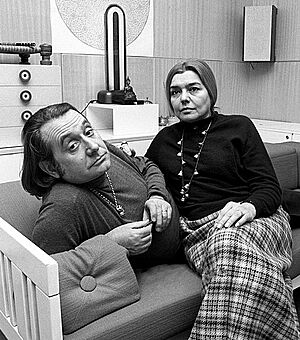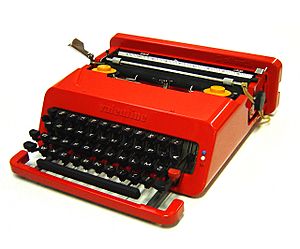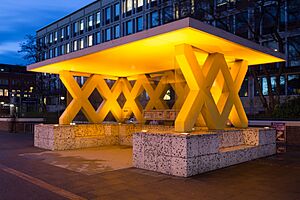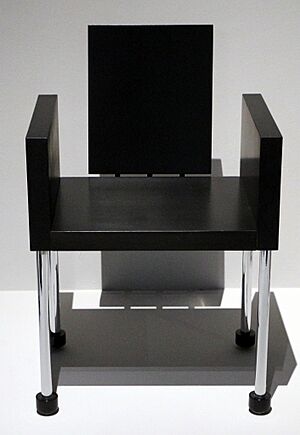Ettore Sottsass facts for kids
Quick facts for kids
Ettore Sottsass
|
|
|---|---|
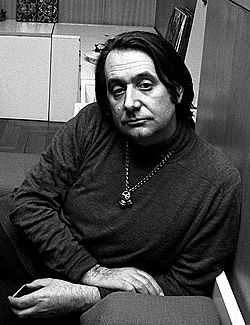
Ettore Sottsass in 1969
|
|
| Born | 14 September 1917 |
| Died | 31 December 2007 (aged 90) |
| Nationality | Italian |
| Occupation | Architect |
| Practice | Sottsass Associati |
| Buildings | Mayer-Schwarz Gallery Beverly Hills, California |
Ettore Sottsass (born September 14, 1917 – died December 31, 2007) was a famous Italian architect and designer. He designed many things, like furniture, jewelry, glass items, lights, home decorations, and even office machines. He also designed buildings and their interiors. His designs were known for their bright colors, bold shapes, and fun decorations. Ettore Sottsass was a very important person in the history of design.
Contents
Early Life and Education
Sottsass was born in Innsbruck, Austria. He grew up in Turin, Italy. His father, also named Ettore Sottsass, was an architect. His father was part of a group of architects who liked modern designs.
The younger Sottsass studied at the Politecnico di Torino in Turin. He earned his degree in architecture in 1939. He served in the Italian military during World War II. During this time, he was held in a prison and a labor camp in Yugoslavia.
After the war, Sottsass opened his own design company in Milan, Italy. Here, he started designing furniture. He loved to try out different colors, patterns, and shapes. His work often had a fun, pop-art style. Many of his pieces were made from glass and ceramic.
Starting His Design Career
After returning home, Ettore Sottsass first worked with his father. They often designed new, modern buildings. These buildings replaced ones that were destroyed during the war. In 1947, he started his own studio in Milan.
He began creating art and designs using many different materials. These included ceramic, paint, sculptures, furniture, and jewelry. He also worked on architecture and interior design.
In 1949, Sottsass married Fernanda Pivano. She was a writer and journalist. In 1956, Sottsass traveled to New York City. He worked for a famous designer named George Nelson. After a few months, he and Pivano returned to Italy.
Also in 1956, an American businessman asked Sottsass to create an exhibition of his ceramic art.
Back in Italy in 1957, Sottsass joined Poltronova. This company made modern furniture. He became their artistic consultant. Many of the furniture designs he worked on here later influenced his work with Memphis Milano.
Designing for Olivetti
In 1956, Sottsass was hired by Adriano Olivetti. Olivetti was a big company that made office machines. Sottsass was asked to design electronic devices. He helped create the first Italian mainframe computer, the Elea 9003. For this, he won a special award called the Compasso d'Oro in 1959.
He also designed office equipment, typewriters, and furniture for Olivetti. Sottsass became known for making office machines look cool and colorful. He used bright colors and interesting shapes. His first typewriters, the Tekne 3 and the Praxis 48, looked very simple and angular.
In 1969, Sottsass worked with Perry A. King to create the Valentine typewriter. This bright red, portable typewriter became a famous design. It is now seen as a very important design from the 20th century.
While working for Olivetti in the 1960s, Sottsass also created other objects. These designs showed his experiences from traveling in the United States and India. He made large ceramic sculptures that looked like altars. He also created his "Superboxes." These were bold, colorful boxes covered in special patterns. They were like early ideas for the Memphis Group designs that came much later.
Sottsass felt that he didn't want to make only "consumer products" anymore. He wanted to try new things. So, from the late 1960s to the 1970s, he worked with younger designers. This led to the start of the Memphis Group in the 1980s.
In the 1970s, he designed the Synthesis 45 office equipment. Sottsass and Fernanda Pivano divorced in 1970. In 1976, Sottsass married Barbara Radice, an art critic.
Roberto Olivetti later became the head of the company. He offered Sottsass a high-paying job as artistic director. But Sottsass said no. Instead, he created his own design studio, separate from Olivetti. This studio became a very creative place for design. In 1968, the Royal College of Art in London gave Sottsass an honorary doctorate degree.
The Memphis Group
In the late 1970s, many new design groups were experimenting with handmade items. In October 1980, Sottsass got two offers. One was from an old friend who wanted to "make something together." The other was from gallery owners who asked him to create "new furniture" for their gallery.
Ettore Sottsass started the Memphis Group in Milan on December 11, 1980. The group got its name from a Bob Dylan song. The Memphis Group was active from 1981 to 1988. They wanted to create designs that were "radical, funny, and outrageous." They didn't care about what was considered "good taste" at the time.
Their work was inspired by Art Deco, the bright colors of Pop Art, and 1950s Kitsch styles. They often used colorful laminate and terrazzo materials. These materials appeared in their floors, tables, and lamps.
Sottsass also designed his own pattern called "Bacterio." He got the idea for this pattern from a Buddhist temple in India. He turned the temple's surface texture into squiggly lines. This pattern was then used on their furniture as coverings and fabrics.
The Memphis Group was a postmodern design group. They focused a lot on furniture design. They were known for their bright, bold pieces with clashing colors. At that time, furniture was mostly meant to be useful. But the Memphis Group wanted to show that furniture could also be decorative art.
Many people criticized their ideas at first. They said it was just a trend that wouldn't last. However, their unusual ideas are now widely recognized and loved. Their work continues to influence designers around the world. You can see their designs in famous museums like the Art Institute of Chicago and The Museum of Modern Art in New York.
Sottsass Associati
As the Memphis movement became famous worldwide, Ettore Sottsass started a big design company. He called it Sottsass Associati. It was started in 1980. This allowed him to design large buildings and work for big international companies.
Besides Ettore Sottsass, other founding members included Aldo Cibic and Matteo Thun. In 1985, Sottsass left the Memphis Group to focus on Sottsass Associati.
Sottsass Associati mainly worked on architecture. But they also designed stores and showrooms for companies like Esprit. They created designs for Alessi, exhibitions, and interiors. They also designed electronics in Japan and all kinds of furniture.
The studio was guided by Ettore Sottsass's ideas. Many young designers worked there. They often left to start their own studios. Sottsass Associati is now based in London and Milan. They continue to follow Sottsass's work and ideas.
The studio works with former Memphis members and other designers. They work for big companies like Apple, Philips, Siemens, Zanotta, Fiat, and Alessi. They also design the inside of all Esprit retail shops.
Famous Designs by Ettore Sottsass
Ettore Sottsass created many famous designs. Here are some of them:
- Valentine typewriter, made for Olivetti in 1969.
- Superbox cabinet, made for Poltronova in 1966.
- Ultrafragola mirror, made for Poltronova in 1970.
- Tahiti lamp, part of the Memphis collection in 1981.
- Murmansk fruit bowl, part of the Memphis collection in 1982.
- Carlton bookcase, part of the Memphis collection in 1981.
- Malabar bookcase, part of the Memphis collection in 1981.
- Casablanca cabinet, part of the Memphis collection in 1981.
- Enorme phone, designed in 1986.
- Miss don't you like caviar chair, designed in 1987.
- Memories of China collection, for the Gallery Mourmans in 1996.
- Mandarin chair, for Knoll in 1986.
- Glass works for Venini and the CIRVA.
- Nuovo Milano cutlery set, designed with Alberto Gozzi for Alessi in 1987. It won an award in 1991.
- Twergi collection, for Alessi in 1989.
Notable Buildings and Architecture
Sottsass also designed many buildings and spaces:
- Fiorucci store, 1980.
- Esprit showrooms in Düsseldorf, Zurich, and Hamburg, 1985.
- Building in Marina di Massa, 1985.
- Alessi showroom in Milan, 1985.
- Wolf house in Ridgway, Colorado, 1985 (with Johanna Grawunder).
- Zibibbo bar in Fukuoka, 1989.
- Olabuenaga house in Maui, 1989 (with Johanna Grawunder).
- Cei house in Empoli, 1989.
- Bischofberger house in Zurich, 1989 (with Johanna Grawunder).
- Museum of Contemporary Art in Ravenne, 1992.
- Ghella house in Roma, 1993.
- Green house in London, 1993.
- Motoryacht Amazon Express, 1994.
- Golf and club resort in Zhaoqing, 1994.
- Malpensa Airport interiors in Milan, 1994.
- Nanon house in Lanaken, 1995.
- Van Impe house in Sint-Lievens-Houtem, 1996.
- Alitalia waiting room, 1997.
- Roppongi Island in Tokyo, 2004.
- Sport house in Nanjing, 2004.
Legacy and Exhibitions
As an industrial designer, Sottsass worked with many companies. These included Fiorucci, Esprit, Poltronova, Knoll International, Alessi, and Brondi. As an architect, he designed the Mayer-Schwarz Gallery in Beverly Hills, California. He also designed the home of David M. Kelley, who designed Apple's first computer mouse.
Sottsass created a huge amount of work. This included furniture, jewelry, ceramics, glass, and buildings. He inspired many architects and designers who came after him. In 2006, the Los Angeles County Museum of Art held a big exhibition of his work. Another exhibition, Ettore Sottsass: Work in Progress, was held in London in 2007.
In 2017, for what would have been Sottsass's 100th birthday, the Met Breuer museum in New York City held an exhibition called Ettore Sottsass: Design Radical.
One of his designs, the Telefono Enorme (Enormous Telephone), is part of the MOMA collection. Many of his designs and drawings are also in the permanent collections of other major museums. These include the Metropolitan Museum of Art and the Design Museum in London.
In 1999, he received the Sir Misha Black award for his contributions to design.
See also
 In Spanish: Ettore Sottsass para niños
In Spanish: Ettore Sottsass para niños


